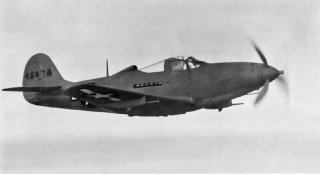American Pilots Hated the P-39 Airacobra - But Russia Loved It
The designers at Bell created a fighter that poorly fit the operational needs of the U.S. military, but that worked just fine for the low-level tactical air war waged by the Soviet Union.
Many histories single out the P-39’s cannon armament as making it an ideal ground attack plane. But in reality, the Soviets did not even acquire anti-tank rounds for the 37-millimeter cannon, and primarily tasked the Airacobra with shooting down enemy bombers and escorting Soviet Il-2 Sturmovik ground attack planes. Soviet Airacobra pilots were willing to ram German aircraft to take them out, and one P-39 ace even downed a German 109 by sawing its tail off with his propeller.
In fact, five of the Soviet Union’s top 10 fighter aces primarily flew P-39s, including the number two scorer Alexander Pokryshin with 59 kills (48 on the P-39) and number four scorer, Grigory Rechkalov (56 kills, all but six on the American fighter), though exact totals vary slightly across sources.
These Soviet aces each individually scored more kills piloting P-39s than any other Allied pilot did flying any American fighter plane in World War II — quite an achievement for a designed deemed inadequate by the U.S. Army Air Corps.
Ultimately, the major role played by the P-39 in the Soviet war effort was underscored by two events that occurred on May 1945 on the eve of the German surrender. A German Me 262 jet fighter shot down a P-39 over Bohemia — the last airplane shot down by the Luftwaffe in World War II. And the following day, a Soviet Airacobra destroyed a twin-engined Focke-Wulf 189 recon plane over Prague — the last Luftwaffe aircraft destroyed in the conflict.
Bell did eventually take a second stab at the P-39 design in the larger P-63 Kingcobra, which featured a four-bladed propeller, laminar flow wings devised by NACA, and — finally — a turbocharger which kicked in whenever the plane flew above 10,000 feet. The Soviet Union even dispatched a test pilot and engineer to advise on the aircraft design.
Though the Kingcobra could attain speeds of 410 miles per hour, the Army Air Corps judged it inferior to the P-51 Mustang and never operated the type except for a small number painted bright orange to serve as “Pinball” practice targets for anti-aircraft guns.
Around 2,400 were delivered to the Soviet Union, however, with a secret agreement restricting their combat use to the brief but decisive Soviet campaign against Japanese forces in Manchuria in August 1945.
It took a few more years before the type faded away from history. A squadron of Soviet P-63s based near Vladivostok was accidentally strafed by U.S. Air Force P-80 jets during the Korean War. Around the same time, 60 French Air Force P-63s served as frontline fighter bombers against the forces of Ho Chi Minh until the aircraft were phased out of service in 1951.
Ironically, the designers at Bell created a fighter that poorly fit the operational needs of the U.S. military, but that worked just fine for the low-level tactical air war waged by the Soviet Union. That just goes to show that application is as important as design in the success of a combat plane. It just so happened that it fell to Soviet pilots to maximize the potential of a much maligned American fighter.
This article originally appeared several years ago.
Image: Wikimedia Commons.

